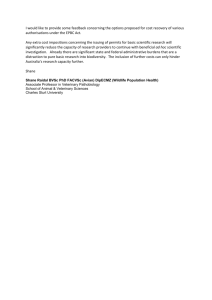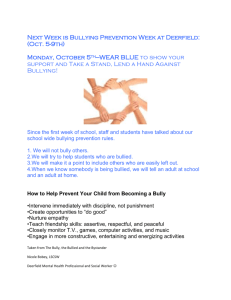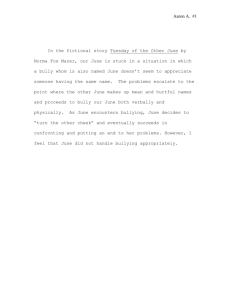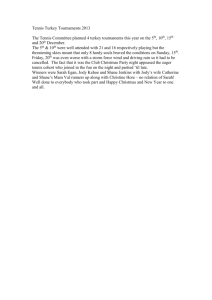Unit 2 Paper Final Draft
advertisement
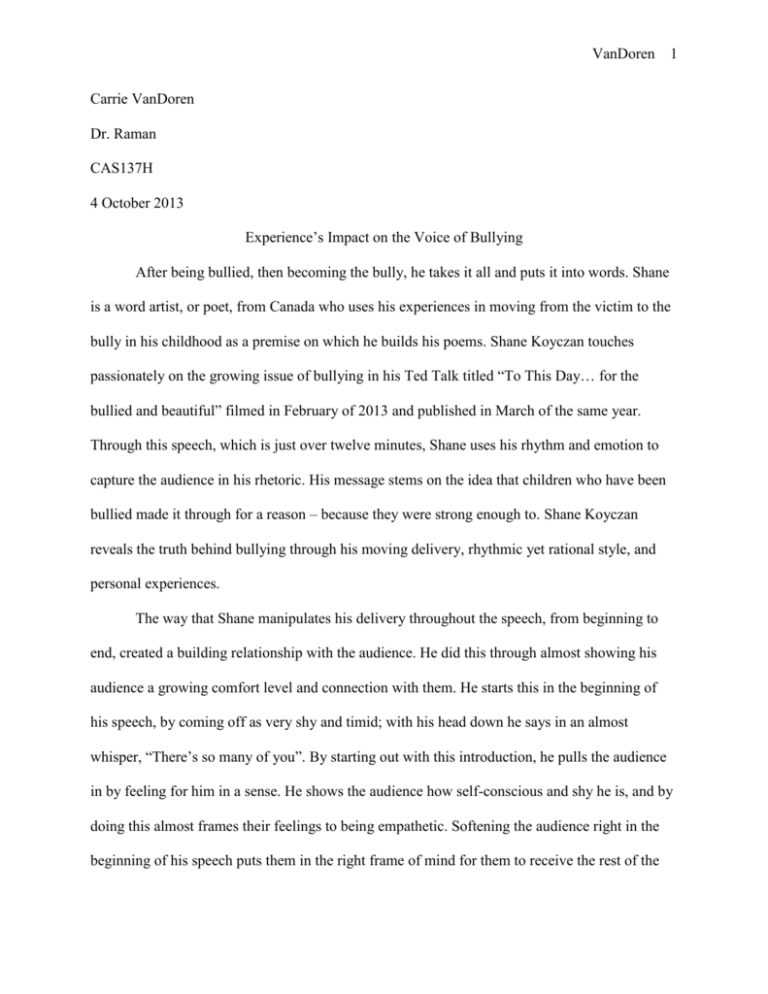
VanDoren 1 Carrie VanDoren Dr. Raman CAS137H 4 October 2013 Experience’s Impact on the Voice of Bullying After being bullied, then becoming the bully, he takes it all and puts it into words. Shane is a word artist, or poet, from Canada who uses his experiences in moving from the victim to the bully in his childhood as a premise on which he builds his poems. Shane Koyczan touches passionately on the growing issue of bullying in his Ted Talk titled “To This Day… for the bullied and beautiful” filmed in February of 2013 and published in March of the same year. Through this speech, which is just over twelve minutes, Shane uses his rhythm and emotion to capture the audience in his rhetoric. His message stems on the idea that children who have been bullied made it through for a reason – because they were strong enough to. Shane Koyczan reveals the truth behind bullying through his moving delivery, rhythmic yet rational style, and personal experiences. The way that Shane manipulates his delivery throughout the speech, from beginning to end, created a building relationship with the audience. He did this through almost showing his audience a growing comfort level and connection with them. He starts this in the beginning of his speech, by coming off as very shy and timid; with his head down he says in an almost whisper, “There’s so many of you”. By starting out with this introduction, he pulls the audience in by feeling for him in a sense. He shows the audience how self-conscious and shy he is, and by doing this almost frames their feelings to being empathetic. Softening the audience right in the beginning of his speech puts them in the right frame of mind for them to receive the rest of the VanDoren 2 speech with the feelings he wants them to feel. This was a very useful strategy and set the stage for the rest of the speech, during which Shane opened up to the audience in a more emotional and revealing way. He shares more of his own personal stories and childhood dreams, allowing his audience to get to know him better. This sets the audience up for the next section of his speech – the poem with animations – that can also be seen as the most emotional one. Shane breaks out of his shell for this poem, and brings all of his emotion and passion out for the audience to see. Short video shots of the audience show that he also pulls out their emotions as well during this part, as they can be seen with awed faces and wiping away their tears. The stages of his speech bring out a connection on a whole new emotional level that words cannot communicate. However, his words were also a critical part in the building up of emotion that he shared that day. Shane Koyczan’s metaphors and unusual choice of wording bring deeper meaning than what can be seen from the surface of each sentence and appeal to the audience’s emotions through pathos. For example, Koyczan includes in the animated section of his poem, “…and if a kid breaks in a school and no one around chooses to hear, do they make a sound?” This statement is a recreation of the well-known thought-provoking question, “If a tree falls in a forest, and no one is around to hear it, does it make a sound?” The speaker probably included this to call his audience to stop and think about this idea more in depth. He could be referring to his perception, in that if other children ignore those who are getting hurt, are they really being hurt? This specific example brings up an interesting idea that goes completely against his obvious main point that victims of bullying can always be heard and can overcome the pain. If this idea that was brought up is true, then these victims were never really victims in the first place. If nobody else knows, or chooses to acknowledge, they are feeling pain, then are these actually VanDoren 3 feeling anything that could change the outcome of the circumstances? I feel that he uses this ideal to prove the point that other kids probably aren’t going to notice or help the victims. These children need to seek help internally to overcome the hardships of bullying, and in this sense, only then can their fall ‘be heard’. This, and various other examples can be heard throughout his speech. These metaphors all paint vivid pictures in the audience’s minds how dealing with the effects of bullying can feel. One specific vivid statement that Shane includes is “Every school was a big top circus tent, and the pecking order went from acrobats to lion tamers, from clowns to carnies, all of these miles ahead of who we were. We were freaks,” and finishes painting the emotional picture by adding, “…but at night, while the others slept, we kept walking the tightrope”. This causes the audience to put themselves in the shoes of the victims, picturing themselves as the bottom tier on a commonly known hierarchy of status like that of the circus. These kinds of statements are how the speaker really pulls through to the audience. The speaker’s word choice throughout his speech shows his effort in expanding his audiences. Shane realizes that not every single person in the world has been bullied, and so he had to put some thought into what he included in his speech. His explanations had to be proficient in allowing a person without these experiences to be able to understand them. However, he had to do this in a way that did not take away from the rhythm, style, or delivery of the speech itself. So, he tactfully added references to outside knowledge and common societal ideals in throughout his poetry. Both of the examples that I gave in my previous paragraphs are evidence of this too. Everyone in the audience may not understand the social rankings of life in today’s schools, but they probably will have the prior understanding of how the people in a circus are ranked on a status scale – with the “freaks” being at the bottom. I feel that in adding in these little tidbits of references and comparisons, he expands the message of the speech to a VanDoren 4 larger audience. Not only is this speaker’s audience expanded through a textual understanding, but the context of the speech itself brings in a whole new collection of viewers. The speech itself is a TED Talk, which is filmed and published in front of an audience with vast backgrounds and jobs. These people include scholars, professors, CEOs of major cooperate companies, program directors, and many others. Every TED Talk is then posted onto the Internet on the TED Talk website. Here, it is visible to anyone with Internet access, but it is understandable that not everyone will make it a point to visit the website daily. That is why the website itself provides quick and easy ways to share or publish the video to your own social networking accounts or blogs. It is in this way that the video will be put in front of an array of audiences, and this video has. The video of the speech on just the website, has over one million views; on YouTube it is not far behind, with almost 900,000 views on the video uploaded from the official TED Talks account. These numbers do not even include those from social networking sites, blogs, and even just people physically pulling up the video to show someone in person. With this said, it is apparent that Shane Koyczan had to make this speech available to and understood by a very broad audience. With making outside references and inputting little funny stories, he accomplishes this task very well. By including small stories and personal experiences throughout the speech, Shane builds up his credibility through appealing to the audience’s ethos. He shares his own past with bullying and how it made him feel. In fact, in the very beginning of the speech, he includes a chunk of his life using chronological organization about the stages he went through. Shane shares, “And when I was ten, I was told that my parents left because they didn’t want me. When I was eleven, I wanted to be left alone. When I was twelve, I wanted to die. When I was thirteen, I wanted to kill a kid”. He then includes a little later in his speech, “From age fifteen to eighteen, I hated myself VanDoren 5 for becoming the thing that I loathed: a bully”. By giving this timeline of personal experience and roles within the topic, the speaker shows that he has had direct exposure to both sides of the ever-growing problem in today’s schools. This appeal to ethos draws the audience in more and makes this an even stronger piece than it was before. It is now stronger because the audience will want to listen to someone with experience, especially on this sort of topic. In another part of the speech, Shane includes a story of a mishap at school, where a few details of his home life and favorite meal got spread around the students and he “earned [his] first nickname: Porkchop”. He then quickly adds on with a hint of emotion, “To this day, I hate porkchops”. Just by adding that last detail, he changed the whole meaning of the story he had just told. Bullying changed his whole outlook on an area of his life. It may seem like a small and insignificant aversion, being it’s just to his favorite childhood meal, but the point of the story still stands. He is showing that bullying affects many different parts of a child’s life. The speaker uses examples of name-calling to bring attention to how much of a negative impact this can have on victims of bulling. A huge part of bullying that Shane focuses on throughout the speech is the idea of labeling, and how this can have a stronger lasting effect on a child than most people might expect. He suggests how labeling can cause a child to feel helpless and that it makes them feel as if they have no control on how other people see them. One example of this ideal comes out right in the beginning of his speech: “We were expected to define ourselves at such an early age, and if we didn’t do it, others did it for us. Geek. Fatty. Slut. Fag.” He relates the feeling of just having to accept these labels, especially when you have not found a word to describe yourself yet. These words and names stay in the child and create an impression that this is what they actually are. Shane portrays this inability to get rid of this outlook at the beginning of his poem: “…that an ingrown life is something surgeons can cut VanDoren 6 away, that there’s no way for it to metastasize; it does”. The “ingrown life” he is referring to is the ‘self’ the child builds inside, made up of the names other kids are calling them. This can lead to depression and distorted views of one’s own value. Although, as Shane shares at the end of his speech during his motivational ending, each child has already overcome this part of themselves because they are still here. The focus on labeling throughout the speech exemplifies Shane’s commitment to showing children that they can always overcome their victimization. Shane Koyczan’s personal experiences in the topic of bullying come out through his use of poetry and way of delivery to the audience. He builds an emotional bridge to his audience by allowing them to see into the life of a victim of bullying in today’s world. This speech has the ability to reach out to everyone and anyone listening and can move them to do new things and feel new feelings. A child that has gone through similar experiences that Shane has may take away the courage and motivation to overcome the bully, and this part of their life as a whole. A person who has bullied other children will see just how deeply their name-calling and offensive actions can affect the victims they are after and may inspire them to stop. Another person who may not have experienced bullying on a personal level at all will still be able to be more effective and understanding of those who have suffered from bullying and will be capable of providing them with the emotional and physical support they might need. Overall, Shane’s obvious empathy and emotion for people suffering from one of the most prevalent problems in today’s schools make him an effective advocate for his piece of rhetoric. VanDoren 7 Works Cited Koyczan, Shane. "To This Day…for the bullied and beautiful." TED Talks. Mar. 2013. Web. 29 Sept. 2013. <http://www.ted.com/talks/shane_koyczan_to_this_day_for_the_bullied_and_beautiful.ht ml>.
